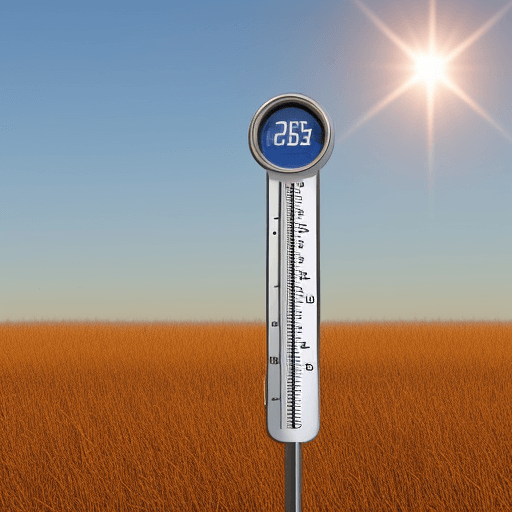How hot is the sun?
Is the sun hotter than regular fire? Is the sun hotter than volcano lava?
This is a question that has puzzled scientists for centuries.
The sun is the source of all life on Earth, and yet we still do not know exactly how hot it is.
Let’s explore the different methods that have been used to measure the temperature of the sun, and we will try to answer the question once and for all!
The sun’s surface is about 10,000 degrees Fahrenheit (5,500 degrees Celsius).

Explain it to a child
The average temperature on the sun’s surface is about 5,500 degrees Celsius. However, it can get much hotter than that near sunspots.
The sun’s core is about 27,000,000 degrees Fahrenheit (15,000,000 degrees Celsius).
How hot is the sun
The average temperature on the sun’s surface is about 5,500 degrees Celsius, but it can get much hotter than that near sunspots.
The highest temperature ever recorded on the sun was almost 20 million degrees Celsius!
Fortunately, we don’t have to worry about the sun’s heat reaching Earth – our atmosphere protects us from most of its harmful radiation.
But even though we’re safe from the sun’s heat, we still need it to live. Without the sun’s energy, there would be no life on Earth!
How hot is the sun in degrees?
The sun is incredibly hot, with a surface temperature of around 10,000 degrees Fahrenheit.
However, the exact temperature of the sun varies depending on its location on the solar spectrum.

For example, the sun’s photosphere, or visible surface, has a temperature of around 6,000 degrees Fahrenheit.
The sun’s atmosphere, meanwhile, can reach temperatures of up to 27 million degrees Fahrenheit.
And given that the average person can only withstand temperatures of around 100 degrees Fahrenheit before suffering from heatstroke, it’s safe to say that the sun is best enjoyed from a distance!
How hot is the sun’s core?
At its core, the sun is incredibly hot, with temperatures reaching 15 million degrees Celsius.

This heat is generated by nuclear fusion, which takes place when hydrogen atoms are fused together to form helium.
The tremendous pressure at the sun’s core causes the hydrogen atoms to collide and fuse together, releasing a huge amount of energy in the process.
The sun’s core is so hot that it emits a continuous stream of high-energy particles known as solar wind.
This wind eventually reaches Earth, where it interacts with our planet’s magnetic field to create the beautiful aurora borealis, also known as the northern lights.
How hot is the sun in Kelvin?
The sun is incredibly hot, with a surface temperature of around 5,500 Kelvin.

But that’s nothing compared to the sun’s core, which has a temperature of around 27 million Kelvin.
That’s nearly 500 times hotter than the surface of the sun!
The sun is so hot because it is constantly undergoing nuclear fusion, which releases huge amounts of energy.
The sun’s core is under immense pressure, which forces atoms of hydrogen to fuse together, releasing huge amounts of heat and light.
The sun will eventually run out of hydrogen to fuse, and when that happens, it will expand and cool down. But for now, the sun continues to burn bright and hot, giving us life and light.
How scientists determined the sun’s core is so much hotter than its surface
Scientists have long known that the sun’s core is incredibly hot, but a recent study has provided new insights into just how hot it really is.
Using data from NASA’s Kepler spacecraft, astronomers were able to map the sun’s internal structure in unprecedented detail.
They found that the core is about 27 million degrees Fahrenheit, which is about 3 million degrees hotter than previously thought.
The findings suggest that the sun’s heat comes from a process called nuclear fusion, in which atoms are combined to form larger atoms.
This process releases a tremendous amount of energy, which drives the sun’s relentless heat output. While the details are still being worked out, this new study provides a valuable glimpse into the inner workings of our nearest star.
The methods used to measure the sun’s temperature
The sun is one of the hottest objects in the solar system, with a surface temperature of around 5500 degrees Celsius.
However, measuring the temperature of such a huge and distant object is no easy task.
In the early 1800s, French astronomer Pierre-Simon Laplace developed a method for estimating the sun’s temperature by measuring the amount of infrared radiation it emits.
This method was later refined by German physicist Hermann von Helmholtz, who used it to estimate the sun’s surface temperature at 6000 degrees Celsius.
However, these estimates were based on theoretical models, and it wasn’t until the late 19th century that actual measurements could be made.
In 1894, American astronomer Samuel Pierpont Langley used a bolometer to measure the intensity of sunlight at different wavelengths.
His findings confirmed that the sun’s surface temperature was indeed around 6000 degrees Celsius.
Today, scientists continue to use bolometers and other sophisticated instruments to study the sun’s radiation and better understand its complex structure and dynamics.
Thus, while we may not know the exact temperature of the sun, we do know that it is essential to life on Earth. Without it, we would all cease to exist.
Article Sources
Jacks of Science sources the most authoritative, trustworthy, and highly recognized institutions for our article research. Learn more about our Editorial Teams process and diligence in verifying the accuracy of every article we publish.
